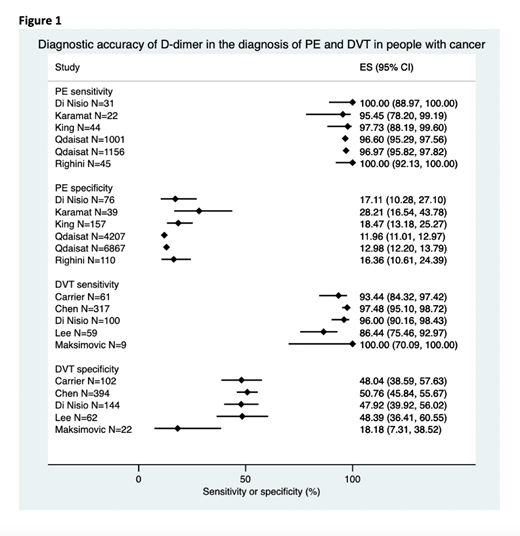Abstract
Introduction
There are evidence-based protocols for the diagnosis and exclusion of pulmonary embolism (PE) and deep vein thrombosis (DVT) which include clinical probability scoring along with selective D-dimer testing and diagnostic imaging. D-dimer assessment in VTE (venous thromboembolism) testing tends to be omitted in patients with cancer, partly because of perceived D-dimer lack of sensitivity and specificity. The aim of this systematic review and meta-analysis was to report the diagnostic accuracy of D-dimer for PE and lower limb DVT in patients with cancer. This study was part of a research program to set International Society of Thrombosis and Haemostasis standards for VTE testing in patients with cancer.
Methods
This systematic review and meta-analysis followed the MOOSE guidelines and was registered in PROSPERO, CRD42020181007. We searched Medline via OVID from conception to 12 th March 2020 for diagnostic PE and DVT studies reporting on people with cancer, or a subgroup of people with cancer. Researchers in the field were contacted for information on unpublished studies. All languages were included. Two researchers screened the titles and abstracts. Four researchers reviewed the selected full texts to determine which studies fulfilled inclusion criteria. Two researchers assessed risk of bias using QUADAS-2, extracted data on the true positive, false positive, true negative and false negative results for D-dimer alone, and D-dimer combined with clinical probability estimation. We used the bivariate random effects method to meta-analyze sensitivity and specificity values. We used a random effects model to estimate pooled false negative rates and efficiency for combining a negative D-dimer (manufacturer recommended cutoff) with a low clinical probability to exclude PE or DVT in patients with cancer. Results were displayed on a Forest plot. Heterogeneity was assessed using I 2.
Results
From 7947 titles and abstracts, we reviewed 49 full text manuscripts, including 13 studies for analysis. Risk of bias was low across all domains for only 5/13 studies. Figures 1 shows the Forest plots grouped by sensitivity and specificity for PE and DVT. The pooled estimates for D-dimer in the diagnosis of VTE in cancer patients (regardless of clinical probability) were 96.4% (95% confidence interval (CI) 94.8 to 97.5%) sensitivity and 26.4% (95% CI 18.1 to 37.0%) specificity. For PE, D-dimer was 96.9% (96.1 to 97.5%) sensitive (I 2 0%, N=2,299) and 14.0% (12.1 to 16.0%) specific, (I 2 69%, N=11,455). For DVT, D-dimer was 94.3% (89.8 to 97.6%) sensitive, (I 2 61%, N=546) and 46.4% (39.8 to 53.3%) specific, (I 2 59%, N=724). The efficiency of combining a low D-dimer (using the manufacturer recommended cutoff) and low clinical probability to exclude DVT or PE was 9.3%, (95% CI 6.9 to 11.9%), N=1,347. There were only 122 patients in the false negative rate analysis of whom 1 patient was diagnosed with VTE in follow up. A pooled analysis was not performed for the false negative rate.
Conclusions
D-dimer is a sensitive test for both PE and lower limb DVT in people who have cancer. Approximately 10% of patients with cancer and suspected VTE can have VTE excluded with D-dimer and clinical probability prior to ordering diagnostic imaging.
No relevant conflicts of interest to declare.


This feature is available to Subscribers Only
Sign In or Create an Account Close Modal